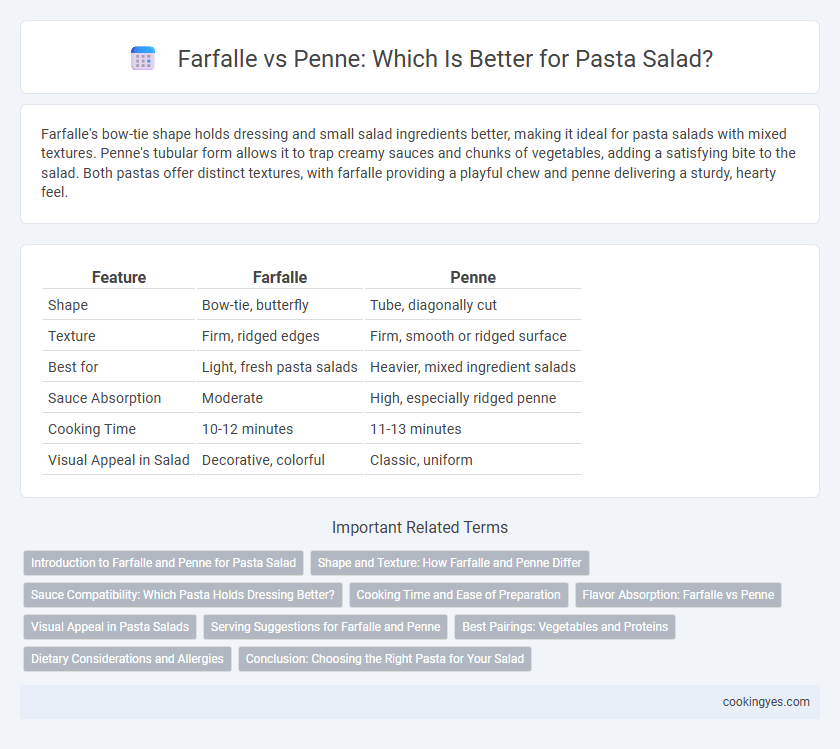Farfalle's bow-tie shape holds dressing and small salad ingredients better, making it ideal for pasta salads with mixed textures. Penne's tubular form allows it to trap creamy sauces and chunks of vegetables, adding a satisfying bite to the salad. Both pastas offer distinct textures, with farfalle providing a playful chew and penne delivering a sturdy, hearty feel.
Table of Comparison
| Feature | Farfalle | Penne |
|---|---|---|
| Shape | Bow-tie, butterfly | Tube, diagonally cut |
| Texture | Firm, ridged edges | Firm, smooth or ridged surface |
| Best for | Light, fresh pasta salads | Heavier, mixed ingredient salads |
| Sauce Absorption | Moderate | High, especially ridged penne |
| Cooking Time | 10-12 minutes | 11-13 minutes |
| Visual Appeal in Salad | Decorative, colorful | Classic, uniform |
Introduction to Farfalle and Penne for Pasta Salad
Farfalle, recognizable by its bow-tie shape, offers a firm texture ideal for holding creamy dressings in pasta salads, while Penne, with its cylindrical tubes and ridges, excels at capturing chunky ingredients and sauces. Both pasta types provide excellent surface area for flavors to cling, enhancing the overall taste experience. Choosing between Farfalle and Penne depends on the desired texture and presentation in the pasta salad.
Shape and Texture: How Farfalle and Penne Differ
Farfalle pasta features a distinctive bow-tie shape with a pinched center, offering a varied texture that holds dressings well in pasta salads. Penne, shaped like short tubes with angled ends, provides a smooth surface and hollow center that trap sauces and ingredients evenly. The firmer bite of penne contrasts with farfalle's tender edges, influencing how each pasta interacts with salad components and dressing absorption.
Sauce Compatibility: Which Pasta Holds Dressing Better?
Farfalle's bow-tie shape with its ridges and folds captures creamy or chunky dressings effectively, allowing sauces to cling inside the pasta pockets, enhancing flavor absorption. Penne's cylindrical form with ridged surfaces excels at holding thicker, oil-based or vinaigrette dressings within its hollow center, making every bite consistently coated. For pasta salad, penne typically retains dressing better due to its tube structure, while farfalle offers more surface area for lighter or textured dressings to adhere.
Cooking Time and Ease of Preparation
Farfalle cooks in about 10-12 minutes, offering a tender texture that holds dressings well, making it ideal for pasta salads. Penne requires a similar cooking time of 11-13 minutes but provides a sturdier bite with its tubular shape that traps sauces effectively. Both pasta types are easy to prepare, but penne's uniform shape often simplifies portioning and mixing in salads.
Flavor Absorption: Farfalle vs Penne
Penne's ridged surface and hollow center excel at trapping dressings and flavors, making it ideal for pasta salad with bold, robust ingredients. Farfalle's smooth, flat shape absorbs less dressing but provides a pleasing texture contrast, allowing more distinct flavors from mix-ins like vegetables and herbs to shine. Choosing penne enhances flavor infusion, while farfalle offers a balanced taste and texture experience in pasta salads.
Visual Appeal in Pasta Salads
Farfalle pasta offers a unique bow-tie shape that adds a playful and decorative element to pasta salads, enhancing visual appeal with its textured edges and vibrant sauce retention. Penne, with its tubular structure and ridged surface, provides a more uniform appearance while effectively capturing dressing and ingredients inside its hollow center. Choosing farfalle emphasizes an eye-catching, varied presentation, whereas penne supports a neat, consistent look that complements chunky, robust pasta salad recipes.
Serving Suggestions for Farfalle and Penne
Farfalle's bow-tie shape holds creamy dressings and chopped vegetables, making it ideal for vibrant pasta salads with fresh herbs, cherry tomatoes, and mozzarella. Penne's tubular form captures chunky ingredients like diced cucumbers, olives, and feta, perfect for Mediterranean-style salads enhanced with Kalamata olives and sun-dried tomatoes. Both farfalle and penne pair well with protein options such as grilled chicken or chickpeas, increasing texture variety and nutritional value.
Best Pairings: Vegetables and Proteins
Farfalle pairs exceptionally well with crisp vegetables like cherry tomatoes, cucumbers, and bell peppers, while complementing proteins such as grilled chicken, shrimp, and mozzarella for a refreshing pasta salad. Penne's ridged texture holds dressings effectively and works best with robust vegetables like roasted zucchini, sun-dried tomatoes, and olives, alongside proteins like Italian sausage, tuna, and feta cheese. Choosing between Farfalle and Penne depends on the desired flavor balance and texture, optimizing the harmony between fresh vegetables and savory proteins in your pasta salad.
Dietary Considerations and Allergies
Farfalle and penne both serve well in pasta salads, but farfalle's bow-tie shape may hold more dressing and mix-ins, enhancing flavor for gluten-free or low-GI pasta alternatives. Penne provides a sturdier texture, suitable for accommodating dairy-free or vegan dressings often preferred in allergen-sensitive diets. Choosing between farfalle and penne depends on specific dietary needs, such as gluten intolerance or nut allergies, ensuring safe and flavorful pasta salad options.
Conclusion: Choosing the Right Pasta for Your Salad
Farfalle offers a delicate texture and butterfly shape that holds light dressings and small salad ingredients well, enhancing visual appeal and bite consistency. Penne provides a ridged surface that captures thicker dressings and chunky vegetables, making it ideal for heartier, robust pasta salads. Selecting the right pasta depends on the salad's texture and dressing, with farfalle suited for lighter, more decorative salads and penne preferred for substantial, flavor-packed combinations.
Farfalle vs Penne for Pasta Salad Infographic

 cookingyes.com
cookingyes.com